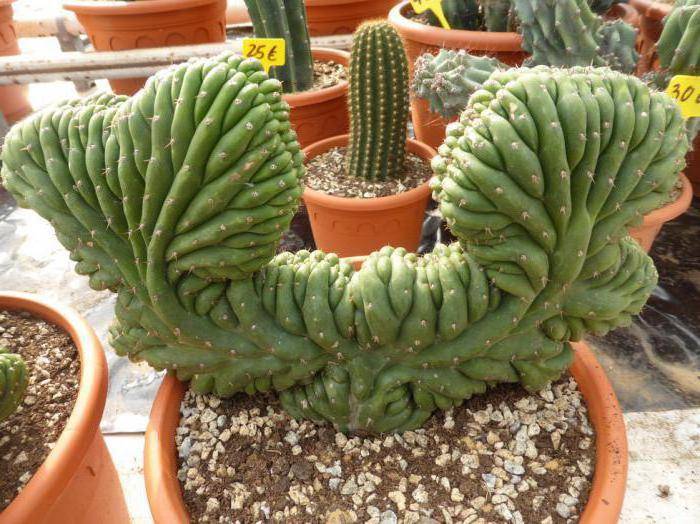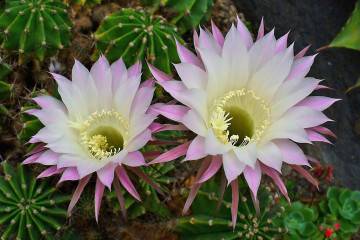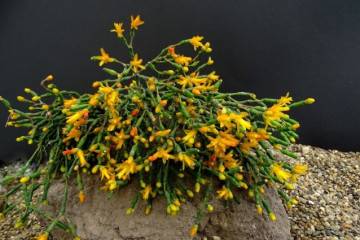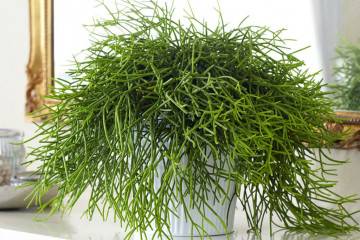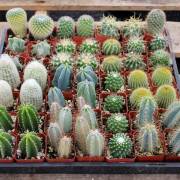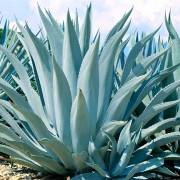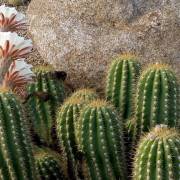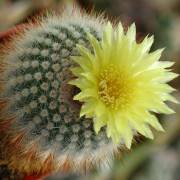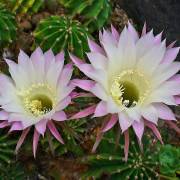Cereus Peruvian - home care
Content:
South America is considered the birthplace of the Peruvian cereus. Under natural conditions, its height ranges from 3 to 10 m. The succulent withstands prolonged drought due to the impressive supply of water in the stems, which reaches up to 200 liters. The appearance of the plant corresponds to the translation of its name - a wax candle.
What does the Peruvian cereus look like and which family it belongs to
The diverse family of Cactus includes the genus Cereus. The Peruvian cereus species attracted lovers of home floriculture.
At home, the plant grows up to 10 m in height, at home - up to 1.5-2 m. A powerful and fleshy stem of a dusty green color in an adult specimen and a light green shade in a young specimen. With age, the main trunk becomes stiff.
Cereus forms several shoots with a waxy coating and pronounced 6-8 ribs. Areoles are rarely brownish-gray. The radial spines are stiff and more than a centimeter long; the needle-like spine in the center is even longer and has a different shade.
The Peruvian Cereus is distinguished by a top with tomentose pubescence and a bluish-gray waxy bloom.
Cereus flowers are tubular, large, 15 cm long. The color of the petals is white, sometimes slightly pinkish. The aroma is unpleasant.
The fruit is a round juicy berry up to 6 cm in diameter with a delicate aroma. The color ranges from yellow to orange. There are large seeds inside the pulp.
Common varieties
Out of 50 species of Cereus, connoisseurs of cacti, in addition to the Peruvian cereus, have selected the most interesting species.
Cereus Spiralis — it is a massive columnar cactus that attracts with its spiral, twisted shoot. It is possible that the cereus owes its spirals to a unique mutation. At home, it grows up to 3-5 m. The shape of the stems is spherical, embossed or flat. Ribs with gray areoles, thorns reach 2-3 cm. Spiral Cereus blooms with white inflorescences with a pinkish tint, after which large coral berries appear.
Cereus azure stretches up to 3 m. Its fleshy stem is decorated with many lateral shoots with a characteristic blue bloom. Slightly wavy ribs (6-7 pcs.) Not pronounced, pubescent. Radial spines are light, 5-8 pcs., In areoles of brown shades. The spines in the center are dark, almost black in color. Flowers are white, large with a strong pleasant aroma.
Cereus giant was awarded the Guinness Book of Records. It is considered the tallest cactus, capable of growing up to 20 m. Its general appearance resembles a huge candelabrum. The number of blunt ribs ranges from 10 to 24 pieces. The spines are up to 7 cm long. In seedlings, atrophied leaves in the form of scales are noticeable. It blooms in early summer with single flowers that develop on the tubercles of the succulent. Regularly shaped tubular flowers are represented by a wide palette:
- white;
- purple;
- yellow;
- green;
- orange.
Blooms at night.
Cereus monstrous has an exotic look. This plant is a tangle of accreted shoots with outgrowths of various shapes.
Monstrose forms can only be propagated vegetatively; when propagated by seeds, a cactus with normal development is obtained. The reasons for the mutation are unknown and cannot be reproduced.
Cactus has stems with different ribs that are bluish. When breeding at home, it grows up to one and a half meters in height, in natural conditions it reaches five meters.
Chaotic growth leads to unpredictable bush shapes. On a monstrous plant, a shoot with normal development may appear.
Cereus Yamakaru differs from other species in multiple light green shoots on a cylindrical stem. Its bole grows up to 35 cm in diameter. The ribs, the number of which reaches 10, are high. With the development of the plant, they become overgrown with tubercles. The flowers are white-green, considered the largest among the Cereus.
The color of the fruit of the Yamakaru cereus is from carmine to dark red, the flesh of the berry is white.
Features of caring for a plant at home
At home, caring for Peruvian Cereus is easy to provide. You just need to create comfort for the plant for growth, take care of the cactus, taking into account its needs.
Temperature
In the summertime, Cereus tolerates high temperatures well and its small drops at night. They feel comfortable at a temperature of 24-26 ° C, calmly withstand heat up to 40 ° C. In the winter months, the optimum temperature for a plant is considered to be 8-12 ° C.
Lighting
Cereus loves to be in the sun. The plant pot should not be placed on the north side windows. In winter, for comfort, he needs additional lighting. In spring and summer, direct sunlight can burn a cactus, so it needs to be taught to the sun gradually. Blinds on the window will help regulate the amount of sunlight.
Watering
The amount of watering depends on the season. In the spring and summer, the plant is watered moderately. In the fall, watering is reduced. In winter, it is rarely carried out, once a month, especially at low temperatures. The soil should be dry for several days.
Young plants are watered more often, 2-3 times a month. Before watering, the water is defended, brought to room temperature.
Humidity
Cereus is not picky about air humidity indicators. In the heat, he likes spraying with warm water.
Priming
For cereus, a neutral soil is selected. It may be acidic, but by no means alkaline.
When compiling a soil mixture, sand and brick chips are included in it. A high humus content is not required for a cactus. When self-preparing the soil, take 2 parts of turf and one part of the land, peat, sand, brick chips. The mixture is treated with a weak solution of potassium permanganate.
A ready-made mixture for cacti is available for sale.
Drainage is placed at the bottom of the pot.
Top dressing
Top dressing begins in May and ends in July. It is better to apply fertilizers in liquid form. Watering with water enriched with microelements is possible. There are special fertilizers for cacti on sale.
Diluted fertilizers are applied every 2 weeks, because the cereus quickly develops massive shoots.
Features of care during the rest period
The dormant period in the Peruvian cereus begins in winter, after the ripening of the fruits (if any).
The pot is placed in a bright, cool place, avoiding hypothermia of the roots.
When and how it blooms
Cereus Peruvian begins to bloom only after reaching the age of ten. It is difficult to achieve its flowering, you need the coincidence of certain conditions during maintenance. The most common mistakes that prevent the plant from blooming:
- insufficient lighting;
- illiterate content during winter holidays;
- violation of the temperature regime;
- lack of fresh air.
Reproduction
There are two ways to propagate Cereus: stem cuttings or seeds.
Propagation by cuttings
A young, medium-sized stem is selected and carefully separated from the mother plant. The cut on the shoot is dried for several days, and on an adult plant it is sprinkled with activated carbon.
The prepared cutting is planted in a small pot, while the lower part of the cutting only touches the soil, without deepening. Water gently. For stability, the seedling is tied to a peg.
The roots will appear in a month.
Germinating seeds
Seed propagation is carried out in the second half of spring. After sowing, the soil should always be moist, and the temperature should not be lower than 20 ° C.
Before germination, the container is kept in the shade, then transferred to a lighted place.
A month later, spines appear on the shoots, and young plants are transplanted into separate containers.
Transfer
Cereus is ready for transplantation after the end of winter dormancy, in mid-March. An adult plant is transplanted every 4 years, young plants - annually.
The pot is chosen according to the size of the root system, it should be slightly larger than before.
Do not water the cactus before transplanting. After transplanting, watering is carried out after 5 days.
Diseases and pests
The plant should be inspected regularly, especially the folds and underside, to prevent pests or disease from spreading. For a successful fight, you should know the signs of their manifestation:
- mealybug leaves white fluffy spots;
- a spider mite will be given a cobweb and red dots;
- scale insects and false scales drink juice from the plant, they are easy to see - oval brown spots;
- rot is manifested by brown soft spots.
For pest control, insecticidal preparations, soap or alcohol solutions are used. If affected by rot, watering is reduced. Cut out spots to healthy tissue and treat with alcohol.
Signs and superstitions
Magic could not ignore the cacti. Rare flowering and beautiful buds on thorny stems suggest that the energy of the essence of Yang and Yin is hidden in cacti.
The Peruvian Cereus can be kept at the front door, it will protect the house from thieves and robbers.
The succulent loves negative energy, feeds on it. There are recommendations to place this plant near a computer in order to extinguish harmful radiation.
Whether it is true or not, one thing is certain - the Peruvian cactus will decorate any home. Even if it never blooms, its exotic appearance will not leave indifferent a connoisseur of beauty.


